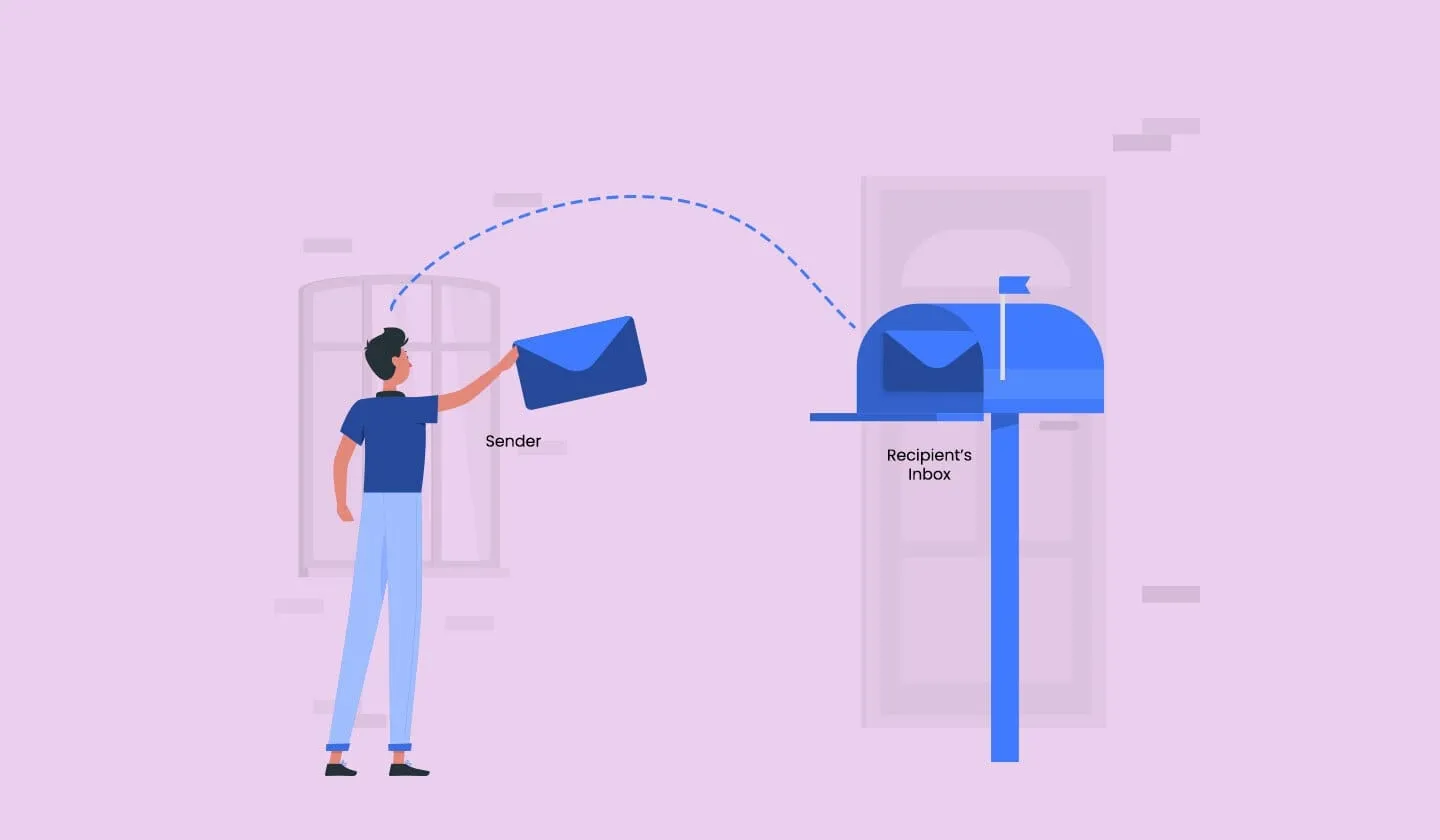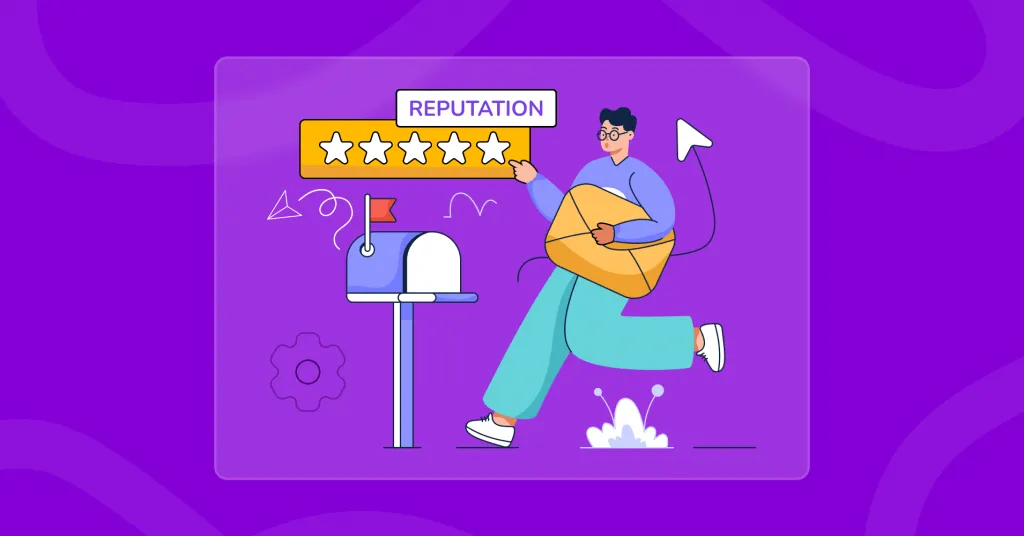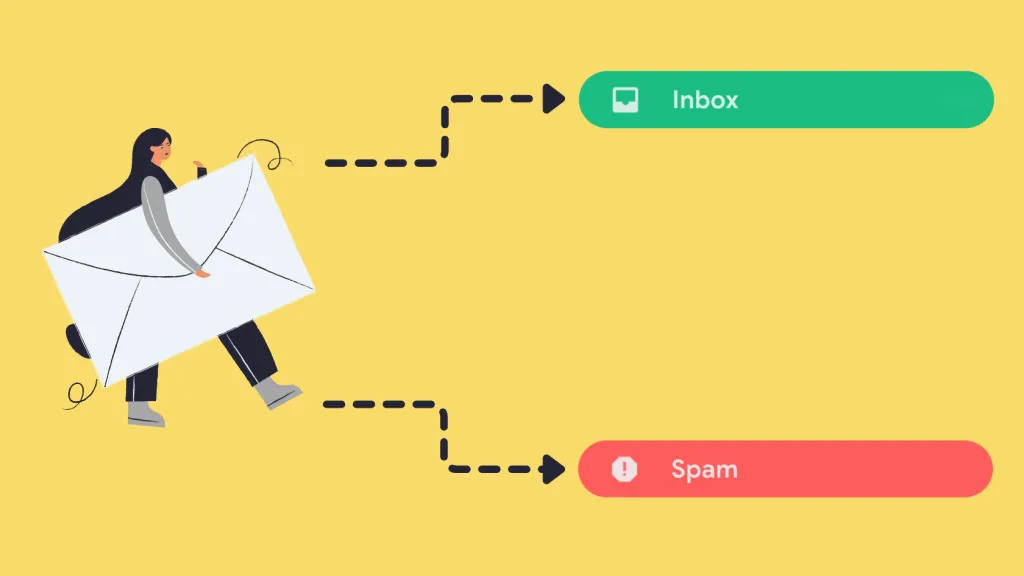Did you know that nearly 20% of marketing emails never reach the inbox? (Source: Validity’s Email Deliverability Benchmark Report 2024). That means almost one in five emails lands in spam or gets blocked before your audience even sees it.
If you’re running email campaigns, getting into inboxes is half the battle. The other half? Getting people to click. Without strong email deliverability and high inbox placement rates, your open rates, click-through rates (CTR), and overall engagement suffer.
In 2025, mailbox providers like Gmail and Outlook are stricter than ever. One wrong move—spam filters, outdated email lists, or poor authentication—and your emails disappear into the void.
This guide will walk you through proven email deliverability best practices. You’ll learn how to avoid spam filters, maintain sender reputation, and optimize email engagement.
What Email Deliverability Refers To

Email deliverability refers to how well your emails reach the intended recipient’s inbox instead of landing in the spam folder. It depends on many factors, like sender reputation, authentication protocols, and engagement rates.
Why does this matter to email marketers? If your emails don’t land in inboxes, your audience never sees them. This hurts email campaigns, subscriber engagement, and click-through rates.
Mailbox providers like Gmail and Outlook use spam filters to decide whether an email is trustworthy. Poor sender reputation, spam complaints, and invalid email addresses can lower your inbox placement rate.
To improve your email deliverability, follow the best practices below, such as authenticating emails, cleaning your list, and avoiding spam traps. A successful email marketing program starts with a strong email infrastructure and proper email domain authentication.
❌Stop losing leads to spam filters! Use Alore’s AI-powered Email Warm-up to build sender reputation and get more emails delivered to inboxes. Start Free Trial
Domain-based message authentication, such as DMARC, helps prevent domain spoofing and phishing attacks by allowing domain owners to define how unauthenticated emails should be handled, thereby enhancing email deliverability and protecting email communications against unauthorized use of the domain.
Essential Email Deliverability Best Practices

To maximize the chances of your emails reaching the intended recipients, it's essential to adhere to effective email deliverability practices. This includes maintaining a clean email list, using a recognizable sender name, and crafting engaging subject lines.
Additionally, the sender's reputation plays a significant role in email delivery success, as it influences whether emails pass through spam filters and reach the inbox or end up in the spam folder.
1. Authenticate Your Emails Properly
Email authentication helps email service providers verify if your emails are safe. Without it, your emails may be flagged as unauthenticated messages and land in the spam folder.
How to do it:
- Set up Sender Policy Framework (SPF), DomainKeys Identified Mail (DKIM), and DMARC. These authentication protocols confirm your email is genuine.
- Use a dedicated IP address to improve your sender reputation over time. Ensure your email domain is secure and verified.
2. Maintain a Clean Email List
Sending emails to invalid email addresses or inactive subscribers can hurt your email deliverability rate. High bounce rates signal internet service providers that you’re not following email deliverability best practices.
How to do it:
- Regularly remove hard bounced email addresses, outdated email addresses, and inactive subscribers.
- Avoid sending emails to spam traps or catch senders—these can damage your sender score. Run re-engagement campaigns to check if subscribers still want your emails.
3. Use a Recognizable Sender Name and Domain
People trust emails from brands and names they recognize. If your sender details look suspicious, your email might get marked as unwanted email or a spam complaint.
How to do it:
- Use a professional email domain instead of free providers like Gmail or Yahoo.
- Keep your sender name consistent across all email campaigns. Encourage subscribers to whitelist your email to improve your inbox placement.
4. Optimize Your Email Sending Frequency
Sending too many emails can annoy your subscribers. Sending too few can make them forget you. Email service providers also track how often you send emails. If you suddenly increase your email campaigns, it may trigger spam filters.
How to do it:
- Start slow if using a new IP address to build a positive sender reputation. Send consistent emails based on subscriber engagement.
- Test different schedules to see what works best for inbox placement. Avoid sudden spikes in sending volume to prevent spam complaints.
5. Write Engaging Subject Lines (Without Spam Triggers!)
A good subject line grabs attention and makes people want to open your email. But if it includes spam trigger words like “FREE” or “URGENT,” it may go straight to the spam folder.
How to do it:
- Use clear, friendly, and relevant subject lines. Keep them short—50 characters or less works best.
- Avoid overly promotional language that sounds like clickbait. Personalize subject lines to increase open rates.
6. Keep Email Content Relevant and Mobile-Friendly
If your content is boring, too long, or hard to read on mobile, people won’t engage. Low engagement hurts your email deliverability and can damage your sender score.
How to do it:
- Make sure emails land properly on all devices. Use easy-to-read fonts, short paragraphs, and clear call-to-actions (CTAs).
- Send relevant content that subscribers expect—not random promotions. Regularly clean your list of inactive subscribers to improve engagement.
7. Monitor Sender Reputation and IP Health
Your sender reputation is like a credit score for your emails. Mailbox providers and email service providers use this score to decide if your email is safe. A low score can lead to email delivery failures or emails going to spam folders.
How to do it:
- Regularly check your sender score using tools like Google Postmaster. Avoid sending emails to spam traps, inactive subscribers, or invalid email addresses.
- Keep your bounce rate low by cleaning your email list. Ensure your IP address and domain reputation remain strong.
8. Warm Up New Email Domains and IPs
If you start sending emails from a new IP address or domain too quickly, your emails may be blocked. Internet service providers see sudden high-volume sending as suspicious.
How to do it:
- Send small amounts of emails at first and gradually increase sending volume. Focus on engaged users first, as they are more likely to interact.
- Use a dedicated IP address for better control over your email deliverability. Monitor your inbox placement rate to ensure emails land correctly.
9. Encourage Subscribers to Whitelist Your Email
Whitelisting means asking your subscribers to mark your emails as safe. This helps prevent emails from getting caught in spam filters.
How to do it:
- Ask new subscribers to add your email address to their contact list. Send a welcome email explaining how to whitelist your email.
- Avoid using spam trigger words or overly promotional language. Keep your emails relevant, mobile-friendly, and easy to read.
Simplify your email marketing with Alore! Monitor email performance, optimize sending schedules, and improve open rates with our advanced Drip Campaigner. Sign up now
How Poor Sender Reputation Affects Email Campaigns

Your sender reputation is like a trust score for your email domain and IP address. If it’s low, your emails may land in the spam folder or get blocked by email service providers.
A poor sender reputation can hurt your email deliverability, making it harder to reach intended recipients' inboxes.
One major cause of a bad sender reputation is too many spam complaints. If users mark your emails as unwanted email, your reputation drops.
Sending emails to invalid email addresses, or inactive addresses of subscribers, or spam traps also damages it. A high bounce rate and sending emails from a new IP address without proper warm-up can also trigger spam filters.
⚠ Bad sender reputation means lost sales! Alore's automated warm-up process ensures your emails avoid spam traps and reach real prospects. Claim Your Free Account and fix deliverability issues today!
What Triggers Spam Filters?
Spam filters protect inboxes from unwanted email. They scan emails and decide if they should go to the spam folder or the recipient's inbox. If your emails trigger spam filters, your email deliverability drops, and fewer people see your messages.
One major trigger is using spam trigger words like "Free," "Guaranteed," or "Urgent." These words make emails look suspicious.
Another trigger is sending too many links or attachments, which email providers may see as risky. Poor sender reputation and using a new IP address without warming it up can also hurt your inbox placement rate.
To avoid spam filters, follow email deliverability best practices. Use authentication protocols like SPF and DKIM. Keep your email content relevant and avoid overly promotional language.
Always send emails to engaged users and clean out invalid email addresses regularly. This helps your emails land in subscribers' inboxes instead of spam.
Key Strategies to Avoid the Spam Folder

1. Maintain a Healthy Email List
Sending emails to inactive subscribers, invalid addresses, email addresses, or spam traps can hurt your sender reputation. This increases the chances of your emails being flagged as unwanted email.
How to do it:
- Regularly remove hard bounced email addresses and outdated email addresses. Monitor your bounce rate and keep it low.
- Use a double opt-in method to confirm real subscribers. Run re-engagement campaigns to check if inactive subscribers still want your emails.
2. Limit the Use of Links and Attachments
Too many links and attachments can make your email look suspicious to spam filters. Internet service providers block emails that contain too many links because they might be phishing attempts.
How to do it:
- Only include one or two trusted links in your emails.
- Avoid using shortened URLs as they look spammy.
- Send attachments only when necessary, and use secure file-sharing services instead.
3. Optimize Email Formatting and Structure
Poorly formatted emails with too many capital letters, spam trigger words, or overly promotional language can get flagged.
How to do it:
- Use clear and professional formatting. Avoid writing in all caps or using too many exclamation marks.
- Keep the email layout mobile-friendly to improve engagement. Use authentication protocols like SPF, DKIM, and DMARC to improve trust with email providers.
4. Monitor Your Blacklist Status
Email providers use blacklists to block spam. If your IP address or email domain is blacklisted, your emails may never reach the inbox.
How to do it:
- Check if your domain or IP address is on a blacklist using tools like MXToolbox. Remove spam complaints and fix any invalid email addresses in your list.
- Follow authentication protocols like SPF, DKIM, and DMARC to improve trust. Keep a positive sender reputation by sending emails to engaged users only.
🚀Never get blacklisted again! Use Alore’s real-time email monitoring to check sender reputation, warm up domains, and fix spam triggers before they hurt your business. Get Started Free.
5. Optimize Email Sending Frequency
Sending too many emails in a short time can trigger spam filters. Sending too few can lower email engagement.
How to do it:
- Find the right balance—send emails regularly but not too often. Monitor bounce rate and inbox placement rate to adjust frequency.
- Avoid sudden spikes in sending, especially from a new IP address. Segment your list and send emails based on subscriber engagement.
Key Metrics to Monitor Email Deliverability

1. Deliverability Rate
The deliverability rate shows the percentage of emails that successfully reach the recipient’s mail server without bouncing.
Formula: Deliverability Rate=(Emails Sent−Bounced Emails/Emails Sent)×100
How to Calculate It: If you send 1,000 emails and 50 bounce, your deliverability rate is: (1000−50/1000)×100=95%
How to improve it:
- Remove invalid email addresses and hard bounced email addresses.
- Use authentication protocols like SPF and DKIM.
- Monitor spam complaints and avoid spam trigger words.
2. Bounce Rate
The bounce rate shows the percentage of emails that failed to reach recipients.
Formula: Bounce Rate=(Bounced Emails/Emails Sent)×100
How to calculate it: If 1,000 emails are sent and 50 bounce, the bounce rate is: (50/1000)×100=5%
How to reduce it:
- Clean your email list to remove outdated email addresses.
- Avoid sending emails to inactive subscribers.
- Use double opt-in to confirm real users.
3. Inbox Placement Rate
This metric shows the percentage of emails that land in the inbox instead of the spam folder.
Formula: Inbox Placement Rate=(Emails in Inbox/Emails Sent−Bounced Emails)×100
How to calculate it: If 950 emails are delivered and 800 land in the inbox, your inbox placement rate is: (800/950)×100=84%
How to increase it:
- Warm up new IP addresses before sending bulk emails.
- Monitor your sender reputation and email domain health.
- Avoid excessive links and attachments to prevent triggering spam filters.
4. Open Rate
The open rate tells you how many recipients opened your email. A low open rate means people might ignore your emails or they are landing in the spam folder.
Formula: Open Rate=(Opened Emails/Delivered Emails)×100
How to calculate it: If you send 1,000 emails, and 200 are opened, your open rate is: (200/1000)×100=20%
How to improve it:
- Use engaging subject lines to catch attention.
- Avoid spam trigger words to prevent emails from being filtered.
- Send emails at the right time for higher subscriber engagement.
5. Click-Through Rate (CTR)
CTR measures how many people clicked on a link inside your email. A low CTR means your email content isn’t encouraging action.
Formula: CTR=(Clicks/Delivered Emails)×100
How to calculate it: If 1,000 emails are delivered, and 50 people click a link, the CTR is: (50/1000)×100=5%
How to increase it:
- Write relevant content that interests readers.
- Place clear call-to-action buttons inside emails.
- Optimize emails for mobile users to make links easy to click.
💡 Higher CTR = More Sales! Optimize subject lines and content with Alore’s AI-powered Email Campaigns to boost clicks and conversions. Sign Up for Free.
6. Domain & IP Reputation Score
This score tells you if email providers trust your email domain and IP address. A low score can lead to emails being blocked.
How to check it:
- Use tools like Google Postmaster Tools or Sender Score.
- Monitor spam complaints and hard bounced email addresses.
- Keep your sender reputation high by following authentication protocols like SPF and DKIM.
7. Forwarding & Reply Rate
This metric measures how many recipients forward or reply to your emails. A high rate means your emails are valuable and engaging.
Email providers like Gmail and Outlook see this as a positive sign, increasing your chances of landing in the inbox placement rate instead of the spam folder.
Formula: \text{Forwarding & Reply Rate} = \left( \frac{\text{Total Forwards} + \text{Total Replies}}{\text{Total Delivered Emails}} \right) \times 100
How to Calculate It:
If you send 1,000 emails, and 50 people forward or reply, the formula is: (50/1000)×100=5%
How to Improve It:
- Write relevant content that encourages replies.
- Ask questions to invite engagement.
- Personalize emails using subscriber engagement data.
- Avoid spam trigger words to ensure emails land in the recipient’s inbox.
Conclusion
Improving email deliverability is key to a successful email marketing program. By following email deliverability best practices, you can avoid the spam folder, reduce bounce rates, and improve open rates. Monitor sender reputation, optimize subject lines, and check your inbox placement rate regularly. Stay updated with email authentication protocols and keep your email list clean. Apply these strategies today and ensure your emails reach the intended recipients' inboxes!

.webp)




.jpg)

